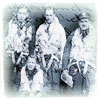Operation Spartan was one of the largest training exercises conducted in Great Britain during WWII. Staged in the first half of March 1943, it employed ten divisions of Army troops along with large numbers of supporting ground and air forces. Under Spartan’s war game scenario, an area in southwestern England was divided into three sections, each under varying degrees of occupation and control by “Allied,” “German,” and “Neutral” forces.
The Advance Post was Operation Spartan’s daily newspaper, explained in its own words as:
“The original intention was that the British Army should have a lithographed news-sheet which would both excite and maintain their interest in the Exercise just completed, as well as furnishing them with at least the world’s news headlines of the real war, day by day. In other words, to put you in the Exercise picture and keep you there, letting you see what was happening on the broad, as well as the narrow, front.” (Issue No. 13)
The papers were received by the Canadian Letters & Images Project as part of the Robert James Duncan Collection.
Content notes:
The collection consists of eight issues the Advance Post, dated March 6-13.
By nature of their creation, the core content of each of the papers is simultaneously both factual and fictitious. On the one hand they may be considered to follow the tradition of “spoof-paper” publications, in that many of the articles describe events that clearly never took place (e.g., the headline “German Atrocities in Oxford”). On the other hand, the occurrences described and individual stories told all represent a factual reporting of real events as experienced throughout Operation Spartan. Supplementary articles that provided readers with genuine news about non-Spartan related events (such as updates on the latest Canadian Hockey scores), also support a view of the Advance Post as following in the tradition of a regular trench newspaper, intended not to deceive but to inform and entertain its soldier audience.
Included with all transcriptions is a warning about the importance of understanding context when interpreting these materials.




